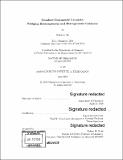Graphite-conjugated catalysts : bridging heterogeneous and homogeneous catalysts
Author(s)
Oh, Seokjoon.
Download1124073519-MIT.pdf (16.35Mb)
Other Contributors
Massachusetts Institute of Technology. Department of Chemistry.
Advisor
Yogesh Surendranath.
Terms of use
Metadata
Show full item recordAbstract
This interconversion occurs via complex multistep, multielectron reactions, which can be carried out by either metallic heterogeneous or molecular homogeneous electrocatalysts. Metallic heterogeneous catalysts have a continuum of electronic states that distribute the redox burden of multielectron reactions, allowing for efficient catalysis. However, heterogeneous catalysts display a variety of active sites and local electronic structures, and are difficult to fine-tune at a molecular level. On the other hand, homogeneous catalysts allow a great degree of synthetic control over the catalytic active site. Moreover, the relative ease in spectroscopic characterization allows a mechanistic understanding of molecular catalysis at a level that is unattainable for heterogeneous catalysis. To bridge the advantages of both types of catalysts, we have developed a surface functionalization strategy for conjugating molecularly well-defined active sites to graphitic carbon surfaces. First, I will discuss the preparation and characterization of two new types of conjugating N-heterocyclic linkages to graphitic carbon surfaces. This work presents a general method for characterizing modified carbon surfaces with molecular-level structural detail. Then, I will present the electrocatalytic carbon dioxide reduction activity of a graphite-conjugated rhenium catalyst, and compare its catalytic behavior to that of a molecular analog. Electrochemical and spectroscopic data show that graphite-conjugated catalysts do not behave identically to their molecular analogs, but rather show properties similar to that of metallic heterogeneous catalysts, providing a unique bridge between the worlds of heterogeneous and homogeneous catalysis. Finally, in the appendix, I will present a chapter on the stability of graphite-conjugated linkages under electrochemical polarization, followed by a chapter on catalyzing the reduction of molecular pyridinium species using a graphite-conjugated rhodium catalyst.
Description
Thesis: Ph. D., Massachusetts Institute of Technology, Department of Chemistry, 2019 Cataloged from PDF version of thesis. Page 156 blank. Includes bibliographical references.
Date issued
2019Department
Massachusetts Institute of Technology. Department of ChemistryPublisher
Massachusetts Institute of Technology
Keywords
Chemistry.